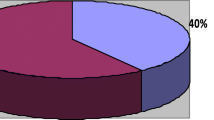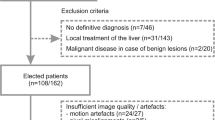Abstract
Objective
To determine whether intravenous administration of gadoxetic acid disodium (Gd-EOB-DTPA) affects lesion conspicuity and apparent diffusion coefficient (ADCs) in diffusion-weighted imaging (DWI) for hepatic magnetic resonance imaging (MRI) at 3.0 T.
Methods
Thirty-four patients with 50 focal hepatic lesions (18 hepatocellular carcinomas, 12 metastases, 1 cholangiocarcinoma, 7 haemangiomas, 12 cysts) underwent DWI at 3.0 T before and after administration of Gd-EOB-DTPA. Non-breath-hold DWI was performed with b values of 0, 200, 400 and 800 s/mm2. Signal-to-noise ratio (SNR) and contrast-to-noise ratio (CNR) of each lesion, and ADCs of the liver and lesion were calculated for unenhanced and enhanced images. Statistical differences between unenhanced and enhanced data were assessed.
Results
SNRs and ADCs of the liver on enhanced images were significantly lower than on unenhanced images. On DW images at b = 200 s/mm2, CNRs of malignant and overall lesions were significantly higher on enhanced than on unenhanced images. CNRs of focal lesions tended to be higher, especially in malignant lesions, on DW images at b = 0 and 400 s/mm2, but without reaching statistical significance. ADCs of focal hepatic lesions were not significantly different before and after administration of contrast agent.
Conclusion
DWI after Gd-EOB-DTPA administration can be used as a substitute for unenhanced DWI at 3.0 T without compromising CNR and ADC of focal hepatic lesions.




Similar content being viewed by others
References
Le Bihan D, Turner R, Douek P, Patronas N (1992) Diffusion MR imaging: clinical applications. AJR Am J Roentgenol 159(3):591–599
Koh DM, Collins DJ (2007) Diffusion-weighted MRI in the body: applications and challenges in oncology. AJR Am J Roentgenol 188:1622–1635
Lang P, Wendland MF, Saeed M et al (1998) Osteogenic sarcoma: noninvasive in vivo assessment of tumor necrosis with diffusion-weighted MR imaging. Radiology 206:227–235
Guo Y, Cai YQ, Cai ZL et al (2002) Differentiation of clinically benign and malignant breast lesions using diffusion-weighted imaging. J Magn Reson Imaging 16:172–178
Okada Y, Ohtomo K, Kiryu S, Sasaki Y (1998) Breath-hold T2-weighted MRI of hepatic tumors: value of echo planar imaging with diffusion-sensitizing gradient. J Comput Assist Tomogr 22:364–371
Koh DM, Scurr E, Collins DJ et al (2006) Colorectal hepatic metastases: quantitative measurements using single-shot echo-planar diffusion-weighted MR imaging. Eur Radiol 16:1898–1905
Ichikawa T, Haradome H, Hachiya J, Nitatori T, Araki T (1998) Diffusion-weighted MR imaging with a single–shot echoplanar sequence: detection and characterization of focal hepatic lesions. AJR Am J Roentgenol 170:397–402
Butts K, Riederer SJ, Ehman RL, Felmlee JP, Grimm RC (1993) Echo-planar imaging of the liver with a standard MR imaging system. Radiology 189:259–264
Nasu K, Kuroki Y, Nawano S et al (2006) Hepatic metastases: diffusion-weighted sensitivity-encoding versus SPIO-enhanced MR imaging. Radiology 239:122–130
Moteki T, Sekine T (2004) Echo planar MR imaging of the liver: comparison of images with and without motion probing gradients. J Magn Reson Imaging 19:82–90
Bruegel M, Holzapfel K, Gaa J et al (2008) Characterization of focal liver lesions by ADC measurements using a respiratory triggered diffusion-weighted single-shot echo-planar MR imaging technique. Eur Radiol 18:477–485
Zech CJ, Herrmann KA, Reiser MF, Schoenberg SO (2007) MR imaging in patients with suspected liver metastases: value of liver-specific contrast agent Gd-EOB-DTPA. Magn Reson Med Sci 6:43–52
Reimer P, Schneider G, Schima W (2004) Hepatobiliary contrast agents for contrast-enhanced MRI of the liver: properties, clinical development and applications. Eur Radiol 14:559–578
Hamm B, Staks T, Muhler A et al (1995) Phase I clinical evaluation of Gd-EOB-DTPA as a hepatobiliary MR contrast agent: safety, pharmacokinetics, and MR imaging. Radiology 195:785–792
Chiu FY, Jao JC, Chen CY et al (2005) Effect of intravenous gadolinium-DTPA on diffusion-weighted magnetic resonance images for evaluation of focal hepatic lesions. J Comput Assist Tomogr 29:176–180
Reimer P, Rummeny EJ, Shamsi K et al (1996) Phase II clinical evaluation of Gd-EOB-DTPA: dose, safety aspects, and pulse sequence. Radiology 199:177–183
Rohrer M, Bauer H, Mintorovitch J, Requardt M, Weinmann HJ (2005) Comparison of magnetic properties of MRI contrast media solutions at different magnetic field strengths. Invest Radiol 40:715–724
Yu SC, Yeung DT, So NM (2004) Imaging features of hepatocellular carcinoma. Clin Radiol 59:145–156
Hussain SM, Zondervan PE, IJzermans JNM, Schalm SW, de Man RA, Krestin GP (2002) Benign versus malignant hepatic nodules: MR imaging findings with pathologic correlation. Radiographics 22:1023–1036; discussion 1037–1029
Hussain SM, Semelka RC, Mitchell DG (2002) MR imaging of hepatocellular carcinoma. Magn Reson Imaging Clin N Am 10:31–52
Elsayes KM, Narra VR, Yin Y, Mukundan G, Lammle M, Brown JJ (2005) Focal hepatic lesions: diagnostic value of enhancement pattern approach with contrast-enhanced 3D gradient-echo MR imaging. Radiographics 25:1299–1320
Bollow M, Taupitz M, Hamm B, Staks T, Wolf KJ, Weinmann HJ (1997) Gadolinium-ethoxybenzyl-DTPA as a hepatobiliary contrast agent for use in MR cholangiography: results of an in vivo phase-I clinical evaluation. Eur Radiol 7:126–132
Author information
Authors and Affiliations
Corresponding author
Rights and permissions
About this article
Cite this article
Choi, J.S., Kim, MJ., Choi, JY. et al. Diffusion-weighted MR imaging of liver on 3.0-Tesla system: effect of intravenous administration of gadoxetic acid disodium. Eur Radiol 20, 1052–1060 (2010). https://doi.org/10.1007/s00330-009-1651-8
Received:
Revised:
Accepted:
Published:
Issue Date:
DOI: https://doi.org/10.1007/s00330-009-1651-8




